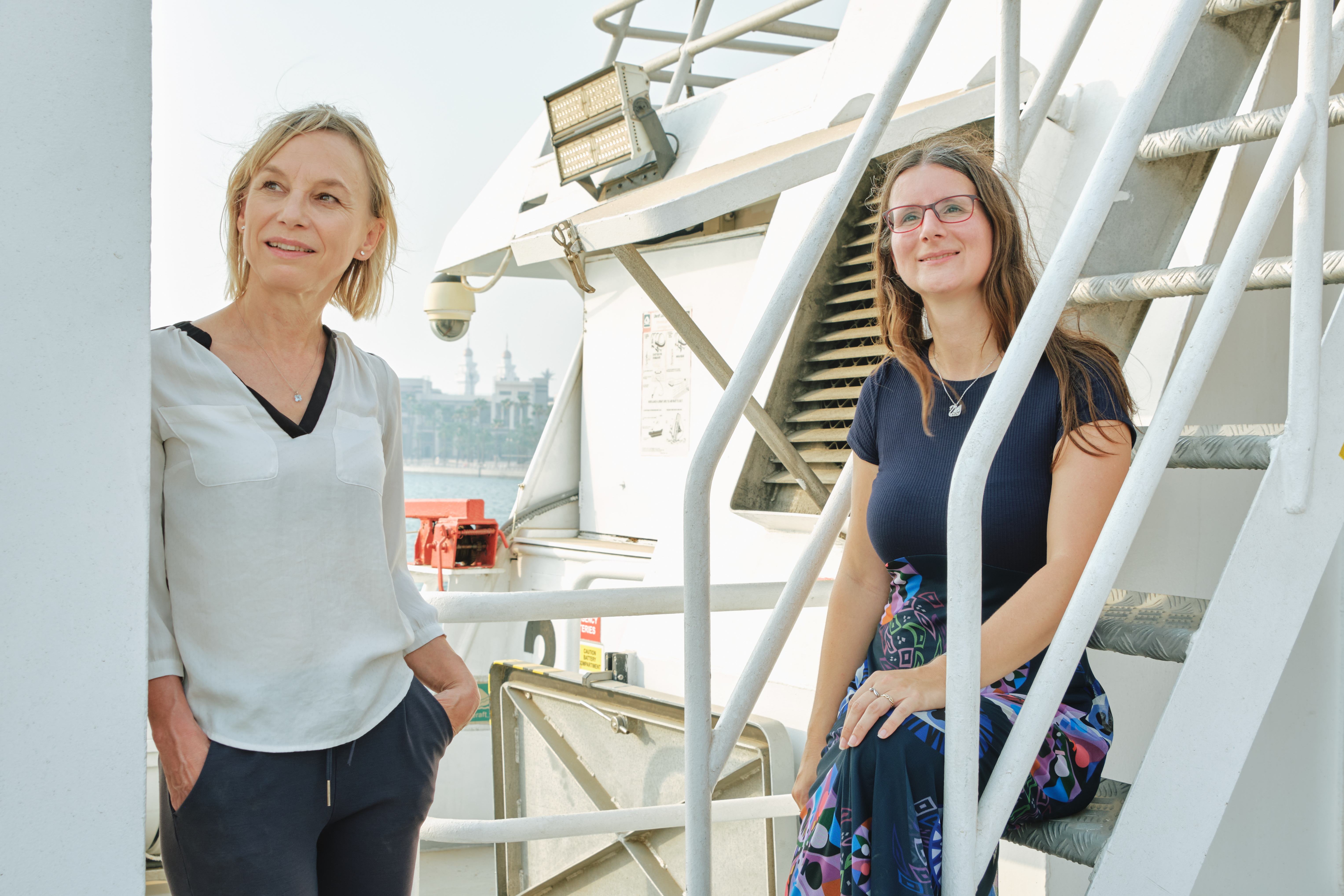Exploring the intricate depths of the Red Sea

Co-chief scientists Hildegard Westphal (left) and Froukje van der Zwan explored the depths of the Red Sea. The collaboration between disciplines facilitated a deeper understanding of these underwater environments. Credit: Eliza Mkhytarian.
Limestone features resembling the Manhattan skyline, underwater hot springs covered with vast microbial mats and deep-sea brine pools with their own wave systems and underwater beaches — all features of the eerie and beautiful world beneath the Red Sea.

Hydrothermal vent fields with microbial mats discovered during the expedition with deep-sea life, such as sharks (top) and anemones (bottom left), and chimneys (bottom right). Credit: M194, GEOMAR ROV team.
During the fall of 2023, two voyages on the German RV Meteor enabled KAUST researchers and colleagues from the Leibniz Centre for Tropical Marine Research in Bremen (ZMT), the GEOMAR Helmholtz Centre for Ocean Research at Kiel, and the Universities of Bremen and Hamburg to examine the deeper reaches of the Red Sea in more detail than ever before.
“The Red Sea is an ocean basin with mature seafloor spreading underway, and its development is similar to the prehistoric Atlantic,” says KAUST faculty and volcanologist Froukje van der Zwan. “This young ocean has much to tell us, not just through its geology but also its unique ecosystems and biodiversity.”
A field trip of a lifetime
Van der Zwan’s initial proposal to bring the Meteor to the Red Sea was put forward six years ago, when she had yet to move to KAUST from Germany. Interest from other eminent researchers, including carbonate sedimentologists Hildegard Westphal — visiting faculty from ZMT and the University of Bremen — and KAUST faculty Volker Vahrenkamp, helped cement plans for the two cruises.
“It is rare to have the chance to bring such a large high-spec research vessel to the Red Sea,” says van der Zwan, co-chief scientist and associate director of the Red Sea Research Center. “We’re indebted to our German collaborators and the German Science Foundation, and also to the KAUST administrative and core lab teams for their logistical support, particularly with securing the relevant permits.”
Each Meteor expedition lasted one month and hosted multidisciplinary research teams and state-of-the-art technologies for mapping, imaging and sampling the seafloor and various geological and biological features. The vessel carried seismic equipment on one cruise and remotely operated underwater vehicles (ROVs) on both trips. The ROVs had robotic arms and other tools for sampling, together with multiple cameras for 360-degree views.

Froukje Van der Zwan and the team used a remotely operated vehicle (ROV) to study the ocean floor of the Red Sea. Credit: Marta Filipa Simões
Research was conducted around the clock with the researchers working in shifts to keep a close eye on the imaging monitors and collaborating to process samples and data.
“The crew and technicians on board provided invaluable support and expertise,” says Westphal. “Best of all, these cruises provide a wonderful opportunity to share ideas. You learn so much from the people you are with, and the discussions spark new collaborations.”
Westphal’s research focuses on carbonate sedimentology, with a particular focus on corals. She examines marine sediments across the world to determine past climate patterns and different stressors on corals and other marine life. She and Vahrenkamp were able to examine underwater carbonate limestone features and collect sediment cores to investigate past climate change.
Deep-sea sediment cores, as collected on both cruises, often provide more comprehensive data than those taken from the land surface. Red Sea cores highlight the waxing and waning fortunes of one of the warmest and most saline oceans on Earth, offering insights into how life may survive in the world’s future oceans.
“The Red Sea’s stressful history likely created the highly resilient organisms we find there today,” says Westphal. “Also, unlike other oceans, the Red Sea is warm right to the bottom, so the deep-water corals and other life-forms are truly unique.” During the trip, the team searched for new organisms, in collaboration with biologists, including members of KAUST faculty Francesca Benzoni’s coral lab.
A new brine find
One special finding was the discovery of a new brine pool. These highly saline, dense pools form at the foot of salt flows — underwater salt “glaciers,” with the brine pools akin to meltwater lakes.
“These brine pools are peculiar, with their own underwater beaches and wave systems,” says Vahrenkamp. “One beach was covered with algae and teeming with tiny shrimps; we watched fascinating shrimp behavior, including two working together like ants to carry a dead fish. It was a career highlight to join this voyage.”

Members of the expedition working during the night shift (Volker Vahrenkamp second from the left and Hildegard Westphal fifth from the left)
Uncovering new hydrothermal vents
Van der Zwan’s focus was to find and study active hydrothermal vent fields — hot springs that rise from cracks in the seabed caused by volcanic activity. “Evidence suggested that the Red Sea must have many of these vents, but we had only recently found the first fields before these cruises began,” she says.
Based on the chemistry of volcanic rocks, sea-floor maps and evidence from the water column, the team were able to pinpoint the most likely places to find the vents.
“On our expedition, we located six new vent fields and gathered an astonishing amount of data and samples,” says van der Zwan. “These fields were very different from what we expected. We were surprised to find mountains of yellow fluffy microbial mats flourishing in the dark warm sea around the hot springs.”

Froukje Van der Zwan and Megan Nolan looking for organisms such as tiny corals living on the rock samples. Credit: Konstantinos Thomaidis.
An interdisciplinary team from KAUST, GEOMAR and collaborating institutes are now studying these unique vent environments in detail.
“The voyages are really just the beginning of the story. We have so many research stories and exciting data that we look forward to sharing with the world,” adds Westphal.

